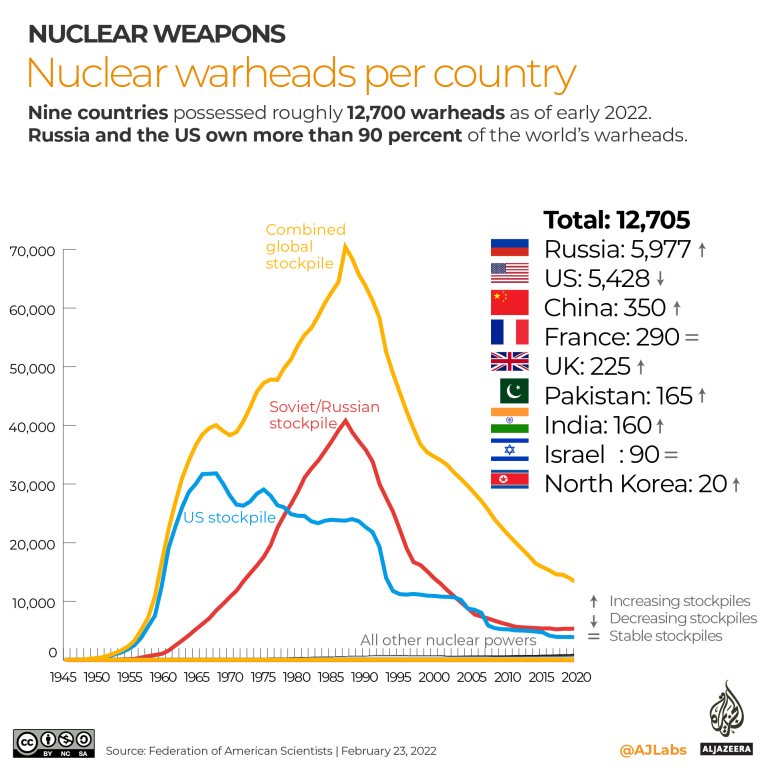Global stockpile of nuclear weapons expected to rise: SIPRI
Swedish arms watchdog says nuclear arsenals are expected to grow in coming years, reversing a decline seen since the Cold War.
![In this photo taken from undated footage distributed by Russian Defense Ministry Press Service, an intercontinental ballistic missile lifts off from a truck-mounted launcher somewhere in Russia. The Russian military said the Avangard hypersonic weapon entered combat duty on Friday. The Kremlin has made modernization of Russia's strategic nuclear forces one of its top priorities [Russian Defense Ministry Press Service via AP]](/wp-content/uploads/2021/02/AP_19361452694694-1.jpg?resize=770%2C513&quality=80)
The global stockpile of nuclear weapons is expected to rise in coming years for the first time since the Cold War due to global tensions, a leading arms watchdog has said.
In its annual report published on Monday (PDF), the Stockholm International Peace Research (SIPRI) said on Monday that all nine nuclear-armed countries are increasing or upgrading their arsenals.
Keep reading
list of 3 itemsRussia warns of nuclear deployment if Sweden, Finland join NATO
The Russia-Ukraine war: An opportunity for nuclear disarmament?
“There are clear indications that the reductions that have characterised global nuclear arsenals since the end of the Cold War have ended,” said Hans Kristensen, associate senior fellow with SIPRI’s Weapons of Mass Destruction Programme and director of the Nuclear Information Project at the Federation of American Scientists (FAS).

Russia with 5,977 warheads and the US, with 5,428, together still possess about 90 percent of all nuclear warheads in the world, according to the report. In 2021, the number of nuclear warheads in both countries declined further, but this was mainly due to the dismantling of discarded warheads, which the military had already abandoned years ago.
Their useable military stockpiles remained relatively stable and within the limits set by a nuclear arms reduction treaty, SIPRI said.
There was a slight reduction in the total number of nuclear warheads to an estimated 12,705 worldwide, this number will probably grow again in the course of the coming decade, the report said.
A reversing trend
For decades, the number of nuclear weapons worldwide has been decreasing steadily. It is now less than one-fifth of what was in the arsenals of the nuclear powers at the height of the Cold War in the 1980s. Last year, however, SIPRI had already identified a trend reversal towards more modern nuclear weapons.
The five UN veto powers, including China, France, Russia, the United Kingdom, and the United States – all of which are nuclear weapon states – declared at the beginning of the year their intention to take action against the further spread of nuclear weapons.
“We emphasise that nuclear war cannot be won and must never be waged,” the US said in a joint statement at the beginning of January.
But SIPRI noted that all five countries had since further expanded or modernised their arsenals. Russia had even openly threatened the possible use of nuclear weapons in the course of its war of aggression in Ukraine.
“Although there were some significant gains in both nuclear arms control and nuclear disarmament in the past year, the risk of nuclear weapons being used seems higher now than at any time since the height of the Cold War,” said SIPRI Director Dan Smith.
‘A very worrying trend’
Also the remaining other nuclear weapon states – India, Israel, North Korea and Pakistan – have all recently developed or deployed new weapon systems or at least announced this, the think-tank said. Israel has never publicly acknowledged having such weapons.
It added that China is in the middle of a “substantial expansion” of its nuclear weapon arsenal, which includes the construction of more than 300 new missile silos. Britain announced last year that it will increase the upper limit for its total stockpile of warheads.
“All of the nuclear-armed states are increasing or upgrading their arsenals and most are sharpening nuclear rhetoric and the role nuclear weapons play in their military strategies,” said Wilfred Wan, the director of SIPRI’s Weapons of Mass Destruction Program. “This is a very worrying trend.”
The new SIPRI data refer to January 2022, the month before Russia invaded Ukraine. It is still a little too early to draw conclusions about how Russia’s war will ultimately affect the nuclear situation in the world, SIPRI’s Kristensen said.
But he already sees an indirect effect. The Russians believe that their conventional forces are not as good as they thought, the expert said about the state of the Russian military. Therefore, Russia is likely to rely more on tactical nuclear weapons in the future. NATO, meanwhile, is reacting to the Ukraine war by emphasising the importance of its nuclear weapons.
The ongoing conflict between India and Pakistan, growing hostilities on the China-India border and North Korea’s ongoing nuclear efforts also play a role. All these things add up, so it is fair to say that the world is in a very precarious state at the moment, Kristensen said.